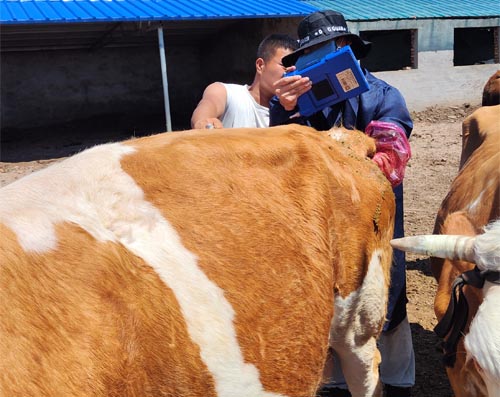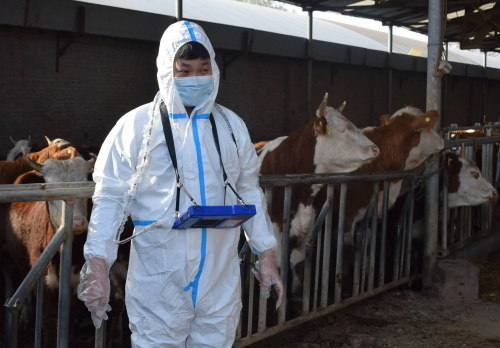Ultrasonography has revolutionized reproductive management in livestock, particularly in dairy and beef cattle. As a livestock farmer, I rely on this non-invasive imaging technique to track ovarian activity, identify optimal superovulation timing, and improve pregnancy rates through synchronization protocols. One of the most practical uses of ultrasonography in my herd is evaluating the number of follicular waves during the estrous cycle and observing changes in the ovaries before and after superovulatory treatment. This allows for more informed decisions that directly impact breeding efficiency and reproductive success.

Understanding Follicular Waves in Cattle
Most cows experience either two or three follicular waves during a typical estrous cycle. The number of these waves influences both the timing of ovulation and the strategy for hormonal treatments such as superovulation.
-
In cows with two follicular waves, the dominant follicle from the second wave is typically the one that ovulates.
-
In cows with three follicular waves, ovulation usually occurs from the dominant follicle of the third wave, which emerges around day 18 of the cycle.
By performing transrectal ultrasonography, I can monitor the growth and regression of these follicles in real time. This not only confirms the wave pattern but also helps pinpoint the optimal moment for reproductive interventions.
Superovulation Timing Based on Follicular Waves
Superovulation protocols are usually initiated between days 8 and 12 of the estrous cycle (day 0 being the day of estrus). The timing aligns with the emergence of a new follicular wave, ensuring that multiple follicles are recruited and respond uniformly to gonadotropin treatment.
-
In cows with three waves, the second wave begins approximately on day 9.5 post-ovulation.
-
In cows with two waves, it starts around day 10.5 post-ovulation.
Therefore, the cycle length also provides clues:
-
Cows with two follicular waves tend to have a shorter estrous cycle (18–20 days).
-
Cows with three waves typically exhibit a longer cycle (21–23 days).
These distinctions are critical. By tracking previous cycle lengths and confirming wave patterns via ultrasonography, I can better determine when to start superovulation for each individual cow.

Ovarian Imaging and Follicular Synchronization
Another key application of ultrasonography in my herd is follicular synchronization, a process aimed at standardizing the stage of follicular development across a group of cows. This is especially useful before initiating fixed-time artificial insemination (FTAI) or embryo transfer.
Prolonged progesterone treatments (longer than 14 days) can negatively affect fertility. Short-term treatments, when combined with prostaglandin injections either just before or concurrent with progesterone withdrawal, have been shown to enhance pregnancy rates—a trend clearly observable through ultrasonographic monitoring.
However, for effective synchronization, it’s essential to ensure that a dominant follicle is present at the time of hormone administration. If not, synchronization of follicular waves becomes necessary.
Follicular Wave Reset via Large Follicle Removal
One technique I’ve used to synchronize follicular development is the removal of large dominant follicles (≥5 mm in diameter) using ultrasound-guided follicular aspiration. Within about 1.5 days, a new synchronized wave of follicles emerges. After this:
-
PGF injections on day 4 (following aspiration)
-
LH or GnRH injections on day 5
These steps can significantly improve the uniformity of ovulation across the group.
However, while this ultrasound-guided puncture technique is effective, it requires a high level of technical skill and specialized equipment, making it less feasible for large-scale commercial operations. It’s mostly practical in smaller herds or research settings where individual monitoring is possible.

Visual Indicators in Ultrasound Imaging
Ultrasound images clearly depict ovarian structures:
-
Follicles appear as anechoic (dark) round structures.
-
Corpora lutea (CLs) present as more echogenic (brighter) solid areas.
-
A sudden drop in follicular size and increased echogenicity typically indicates ovulation.
By examining these patterns, I can distinguish between different stages of follicular development and luteal activity. This enables me to make timely and accurate decisions regarding breeding or hormonal intervention.
Benefits for Herd Reproductive Management
Using ultrasonography to evaluate follicular wave patterns and ovarian changes has multiple advantages:
-
Precision breeding: I can accurately time insemination or embryo collection.
-
Enhanced superovulatory response: By aligning treatment with follicular emergence, I maximize follicle recruitment.
-
Improved conception rates: Synchronization ensures cows are hormonally primed for successful fertilization.
-
Reduced hormonal waste: Treatments are used more effectively and only when they are most likely to yield results.
Overall, integrating ultrasound into my herd’s reproductive program has optimized outcomes and reduced uncertainty. It’s not just about “seeing” what’s happening inside the cow—it’s about translating that information into action.
Challenges and Considerations
Despite its benefits, ultrasonography has limitations. Some key considerations include:
-
Operator dependency: Interpreting ovarian structures accurately requires training and experience.
-
Equipment availability: High-quality ultrasound machines and transducers suited for bovine reproductive work are expensive and may not be accessible to all farms.
-
Time investment: Each cow must be examined individually, which can be labor-intensive for large herds.
Yet, the benefits far outweigh the challenges, especially when dealing with high-value cows or critical reproductive schedules like embryo transfer programs.

Conclusion
Monitoring follicular dynamics and ovarian changes using ultrasonography is a cornerstone of modern cattle reproductive management. From understanding wave patterns to optimizing superovulation timing and enhancing synchronization protocols, the insights I gain from each scan help me make smarter, more efficient decisions.
For any livestock farmer aiming to improve reproductive efficiency and herd fertility, investing in ultrasonography—whether through equipment or professional services—is a decision that pays off in both the short and long term. As herd sizes grow and breeding technologies become more sophisticated, tools like ultrasound are not just helpful—they’re essential.